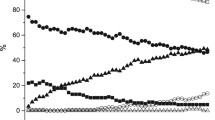Detrended canonical correspondence analysis (DCCA) was applied to explore the species assemblage of plants in a temperate secondary forest that was created by major disturbances. The DCCA showed vague relationships between species dominance and environmental factors for canopy tree species even when rare species were excluded from the analysis. For the highest dominant species of the understorey, the scores of the first axis, which correlated with the species richness of overstorey trees, decreased. This fact showed that the assemblage of canopy trees affects, through the differences in leaf phenology or leaf characteristics of canopy trees, the life history of dominant understorey plants. The study’s results suggest that competition colonization might be more important for canopy trees during the developing stage of the forest if the disturbance occurs on a large scale, and that colonization from the local species pool determines species assemblage on a landscape scale.
Similar content being viewed by others
References
Ter Braak C. J. F. & Smilauer P. (1998) Software for Canonical Community Ordination (Version 4). Microcomputer Power: Ithaca, New York.
Brokaw N. & Busing R. (2000) Niche versus chance and tree diversity in forest gaps. Trends in Ecology and Evolution 15: 183–188.
Cao Y. & Larsen D. P. (2001) Rare species in multivariate analysis for bioassessment: Some considerations. Journal of North American Benthological Society 20: 144–153.
Gauch H. G. (1982) Multivariate Analysis in Community Ecology. Cambridge University Press, Cambridge.
Harvey P. H., Colwell R. K., Silvertown J. V. & May R. M. (1983) Null models in ecology. Annual Review of Ecology and Systematics 14: 189–211.
Hector A., Schmid B., Beierkuhnlein C., Caldeira M. C., Diemer M., Dimitrakopoulos P. G., Finn J. A., Freitas H., Giller P. S., Good J., Harris R., Hogberg P., Huss-Danell K., Joshi J., Jumpponen A., Korner C., Leadley P. W., Loreau M., Minns Mulder C. P. H., O’Donovan G., Otway S. J., Pereira J. S., Prinz A., Read D. J., Scherer-Lorenzen M., Schulze E.-D., Siamantziouras A.-S. D., Sphen E. M., Terry A. C., Troumbis A. Y., Woodward F. I., Yachi S. & Lawton J. H. (1999) Plant diversity and productivity experiments in European grasslands. Science 286: 1123–1127.
Hiura T. (1995) Gap formation and species diversity in Japanese beech forests: A test of the intermediate disturbance hypothesis on a geographic scale. Oecologia 104: 265–271.
Hubbell S. P., Foster R. B., O’Brien S. T., Harms K. E., Condit R., Wechsler B., Wright S. J. & Loo De Lao S. (1999) Light-gap disturbances, recruitment limitation, and tree diversity in a neotropical forest. Science 283: 554–557.
Huston (1997) Hidden treatments in ecological experiments: Re-evaluating the ecosystem function of bio-diversity. Oecologia 110: 449–460.
Igarashi Y. (1987) Vegetational succession in the Tomakomai Experimental Forest area. Research Bulletin of Hokkaido University Forests 44: 405–427.
Kent M. & Coker P. (1992) Vegetation Description and Analysis: A Practical Approach. CRC Press, Boca Raton, LA.
Kikuzawa K. (1988) Leaf survivals of tree species in deciduous broad-leaved forests. Plant Species Biology 3: 67–76.
Koike T. (1988) Leaf structure and photosynthetic performance as related to the forest succession of deciduous broad-leaved trees. Plant Species Biology 3: 77–87.
Kudo Y. & Yoshimi T. (1916) Flora of Tomakomai Experimental Forest, Hokkaido University. Research Bulletin of Tohoku Emperor University Forests 3: 1–62.
Maeno H. & Hiura T. (2000) The effect of leaf phenology of overstory trees on the reproductive success of an understory shrub, Staphylea bumalda DC. Canadian Journal of Botany 78: 781–785.
Mishima T., Taniguchi S., Taniguchi M. & Hishinuma Y. (1958) The actual states of wind damage in the Tomakomai Experimental Forest of Hokkaido University. Research Bulletin of Hokkaido University Forests 19: 1–39.
Nakashizuka T. (2001) Species coexistence in temperate, mixed deciduous forests. Trends in Ecology and Evolution 16: 205–210.
Osawa A. (1992) Development of a mixed-conifer forest in Hokkaido, northern Japan, following a catastrophic windstorm: A ‘parallel’ model of plant succession. In: The Ecology and Silviculture of Mixed-Species Forests. (ed. M. J. Kelty) pp. 29–52. Kluwer, Amsterdam.
Pacala S. W. & Rees M. (1998) Models suggesting field experiments to test two hypotheses explaining successional diversity. American Naturalist 152: 729–737.
Sakuma T. & Sato F. (1987) Dynamics of inorganic elements in soils under deciduous forests. Research Bulletin of Hokkaido University Forests 44: 537–552.
Seiwa K. (1998) Advantages of early germination for growth and survival of seedlings of Acer mono under different overstorey phenologies in deciduous broad-leaved forests. Journal of Ecology 86: 219–228.
Tilman D., Wedin D. & Knops J. (1996) Productivity and sustainability influenced by biodiversity in grassland ecosystems. Nature 379: 718–720.
Uemura S. (1994) Pattern of phenology in forest understory. Canadian Journal of Botany 72: 409–414.
Wilson J. B. (1999) Assembly rules in plant communities. In: Ecological Assembly Rules. (eds E. Weiher & P. Keddy) pp. 130–164. Cambridge University Press, Cambridge.
Author information
Authors and Affiliations
Corresponding author
About this article
Cite this article
Hiura, T. Stochasticity of species assemblage of canopy trees and understorey plants in a temperate secondary forest created by major disturbances. Ecol Res 16, 887–893 (2001). https://doi.org/10.1046/j.1440-1703.2001.00449.x
Accepted:
Issue Date:
DOI: https://doi.org/10.1046/j.1440-1703.2001.00449.x




